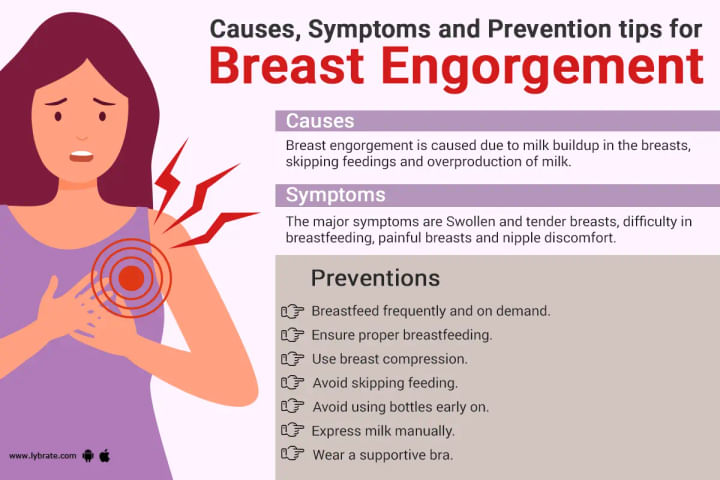Breast Engorgement: Causes, Symptoms, Risks, Care and Prevention
Breast engorgement is a common yet painful condition among breastfeeding mothers, characterized by swollen, hard and tender breasts due to an excessive amount of milk.
It can occur at any point during breastfeeding, and if left untreated, can lead to various complications such as clogged ducts and infections. In this article, we will delve into the causes, symptoms, and effective ways of managing and preventing breast engorgement.
The Milk Rush: Understanding the Causes of Breast Engorgement
The onset of lactation
Your breasts start producing milk anywhere between 2 to 5 days after giving birth. This sudden surge in milk production can cause breast fullness, which is considered normal during the early stages of breastfeeding and is referred to as the 'milk-coming-in' phase. However, if left unmanaged, it can lead to engorgement.
Insufficient breastfeeding
Inadequate breastfeeding or not breastfeeding often enough can lead to engorgement as the milk accumulates in the breasts.
Improper latching
Your infant could be unable to empty the breasts if they are not latching on properly, which could result in engorgement.
Abrupt weaning
Stopping breastfeeding abruptly can also cause engorgement as the milk continues to be produced but with no outlet for release.
The Agony of Engorgement: Recognizing the Symptoms
Recognizing the symptoms of breast engorgement is crucial in getting the proper care and treatment. Common symptoms include:
- Swelling: The breasts become swollen and hard to the touch, appearing firm and painful. In extreme situations, the breasts could feel lumpy, hard, glossy, heated, and highly enlarged.
- Flat nipples: The dark area (areola) around the nipple may be extremely rigid, which makes it challenging for the infant to latch on.
- Nipple tenderness: The nipples may be sore and sensitive, making breastfeeding difficult.
- Pain: The increased blood flow may cause the breasts to feel warm to the touch.
- Heat: The breasts may feel warm to the touch due to increased blood flow.
- Fever: A slight fever of around 100.4°F (38°C) may occur in rare cases.
- Lymph nodes: Swollen and painful lymph nodes in the armpit are possible.
The Dangers of Prolonged Engorgement: Complications and Risks
Prolonged engorgement can lead to several complications, including clogged ducts and mastitis. Clogged ducts occur when milk accumulates in one specific area of the breast, causing pain and tenderness. If left untreated, it can lead to an infection known as mastitis, which is characterized by fever, flu-like symptoms, and a breast lump. Additionally, prolonged engorgement can also lead to a reduction in milk supply as the milk flow is blocked.
The Relief from Engorgement: Strategies for Care
Managing and preventing breast engorgement requires a combination of different strategies. Some effective ways to care for yourself include;`
- Frequent breastfeeding: Breastfeeding as often as possible will help prevent engorgement and keep the milk flowing. To ensure that the breasts are being emptied, check to see that your baby is latching on properly.
- Warm compresses: Before breastfeeding, applying a warm compress to the breasts might help soften them and make it simpler for the infant to latch.
- Hand expression or pumping: Hand expressing or pumping milk can help relieve pressure and prevent engorgement.
- Supportive bra: The breasts can be kept in a comfortable position and engorgement can be avoided by using a supportive bra.
- Medications: Taking ibuprofen or acetaminophen (under a doctor's guidance) can help alleviate pain and discomfort.
For women who are not breastfeeding, the following steps can help relieve discomfort;
- Avoid pumping or removing too much milk from the breasts. Only remove a small amount if the breasts are very painful.
- Apply a cold pack every hour or as needed, for 15 minutes to the breasts. A tiny piece of fabric should be placed between the breast and the cold pack to avoid skin harm.
- In addition to employing non-medical remedies, take ibuprofen (found in Advil or Motrin). Before taking any drug, it's critical to read and abide by all directions on the label.
- To keep the breasts in a comfortable position and avoid engorgement, wear a bra that fits properly and offers appropriate support.
The Prevention is Better than Cure: Tips for Avoiding Engorgement
Preventing breast engorgement is key to avoiding the pain and discomfort associated with it. Some effective ways to prevent engorgement include;
- Breastfeed frequently: Breastfeeding as often as possible, and making sure your baby is latching on correctly can help prevent engorgement.
- Gradual weaning: It's preferable to wean if you must so that your body has time to adjust. This will help decrease the amount of milk gradually and prevent engorgement.
- Supportive bra: A supportive bra can aid in maintaining the breasts in a relaxed position and preventing engorgement.
- Lactation consultant: To manage and avoid engorgement, a lactation consultant can offer tailored advice and techniques. They can also help with proper latching techniques, breastfeeding positions and other breastfeeding related concerns that may be contributing to engorgement.
- Keep track of feeding: Keep a record of the feeding routine of your baby, the time of feeding, how long the feeding lasted, and which breast your baby fed from. This will help you understand which breast needs more stimulation and which one is being overfed.
Conclusion
Breast engorgement is a common yet painful condition among breastfeeding mothers, characterized by swollen, hard and tender breasts due to an excessive amount of milk. Understanding the causes, recognizing the symptoms, and knowing how to care for yourself are crucial in managing and preventing breast engorgement.
It's important to note that engorgement can occur at any point during breastfeeding, and if left untreated, it can lead to various complications such as clogged ducts and infections. However, with the right care and management techniques, it is possible to alleviate the discomfort and continue breastfeeding comfortably. If you have any worries or inquiries, it's crucial to get assistance from a lactation consultant or healthcare professional.



+1.svg)
